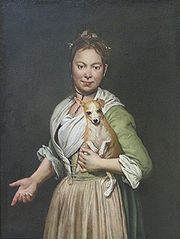
Giacomo Ceruti
Encyclopedia

Italy
Italy , officially the Italian Republic languages]] under the European Charter for Regional or Minority Languages. In each of these, Italy's official name is as follows:;;;;;;;;), is a unitary parliamentary republic in South-Central Europe. To the north it borders France, Switzerland, Austria and...
late Baroque
Baroque
The Baroque is a period and the style that used exaggerated motion and clear, easily interpreted detail to produce drama, tension, exuberance, and grandeur in sculpture, painting, literature, dance, and music...
painter, active in Northern Italy in Milan
Milan
Milan is the second-largest city in Italy and the capital city of the region of Lombardy and of the province of Milan. The city proper has a population of about 1.3 million, while its urban area, roughly coinciding with its administrative province and the bordering Province of Monza and Brianza ,...
, Brescia
Brescia
Brescia is a city and comune in the region of Lombardy in northern Italy. It is situated at the foot of the Alps, between the Mella and the Naviglio, with a population of around 197,000. It is the second largest city in Lombardy, after the capital, Milan...
, and Venice
Venice
Venice is a city in northern Italy which is renowned for the beauty of its setting, its architecture and its artworks. It is the capital of the Veneto region...
. He acquired the nickname Pitocchetto (the little beggar) for his many paintings of peasants dressed in rags.
He was born in Milan, but worked primarily in Brescia. He may have been influenced early by Antonio Cifrondi
Antonio Cifrondi
Antonio Cifrondi was an Italian painter of the late Baroque, mainly of genre themes. He was active in Brescia and near Bergamo....
and/or Giacomo Todesco (Todeschini), and received training from Carlo Ceresa
Carlo Ceresa
Carlo Ceresa was an Italian painter of the Baroque period active mainly around Bergamo.-Biography:...
. While he also painted still-life paintings and religious scenes, Ceruti is best known for his genre paintings, especially of beggars and the poor, whom he painted realistically and endowed with unusual dignity and individuality.
Ceruti gave particular attention to this subject matter during the period 1725 to 1740, and about 50 of his genre paintings from these years survive. Mira Pajes Merriman, in her essay titled Comedy, Reality, and the Development of Genre Painting in Italy, observes that "Generally his figures do almost nothing—after all, they have nothing to do." She describes his paintings as confronting us with
the detritus of the community; the displaced and homeless poor ; the old and the young with their ubiquitous spindles, eloquent signs of their situationless poverty and unwanted labor; orphans in their orderly, joyless asylums plying their unpaid toil; urchins of the streets eking out small coins as porters, and sating them in gambling,; the diseased, palsied, and deformed; lonely vagabonds; even a stranger from Africa—and all in tatters and filthy rags, almost all with eyes that address us directly...
A characteristic painting is his Woman with a Dog (seen above) which portrays a rather plain subject sympathetically and without idealization
Platonic idealism
Platonic idealism usually refers to Plato's theory of forms or doctrine of ideas,Some commentators hold Plato argued that truth is an abstraction...
. Like most of his figures, she appears before an undifferentiated dark background; when Ceruti attempted to represent deep space, the results were frequently awkward. His landscape backgrounds resemble stage flats and are often copied from print sources, such as the engraving
Engraving
Engraving is the practice of incising a design on to a hard, usually flat surface, by cutting grooves into it. The result may be a decorated object in itself, as when silver, gold, steel, or glass are engraved, or may provide an intaglio printing plate, of copper or another metal, for printing...
s of Jacques Callot
Jacques Callot
Jacques Callot was a baroque printmaker and draftsman from the Duchy of Lorraine . He is an important figure in the development of the old master print...
. The realism Ceruti brought to his genre paintings also distinguishes his portrait
Portrait
thumb|250px|right|Portrait of [[Thomas Jefferson]] by [[Rembrandt Peale]], 1805. [[New-York Historical Society]].A portrait is a painting, photograph, sculpture, or other artistic representation of a person, in which the face and its expression is predominant. The intent is to display the likeness,...
s and still life
Still life
A still life is a work of art depicting mostly inanimate subject matter, typically commonplace objects which may be either natural or man-made...
s, while it is less apparent in his somewhat conventional decorative paintings for churches, including frescoes for the Basilica de Gandino
Gandino
Gandino is a comune in the Province of Bergamo in the Italian region of Lombardy, located about 70 km northeast of Milan and about 20 km northeast of Bergamo...
and an altarpiece for Santa Lucia in Padua
Padua
Padua is a city and comune in the Veneto, northern Italy. It is the capital of the province of Padua and the economic and communications hub of the area. Padua's population is 212,500 . The city is sometimes included, with Venice and Treviso, in the Padua-Treviso-Venice Metropolitan Area, having...
. This limitation is not unique to Ceruti; the Brescian painter from the late 16th century, Giovanni Battista Moroni
Giovanni Battista Moroni
Giovanni Battista Moroni was a North Italian painter of the Late Renaissance period. He is also called Giambattista Moroni...
, was similarly known for expressive portraits, and drab religious paintings.

